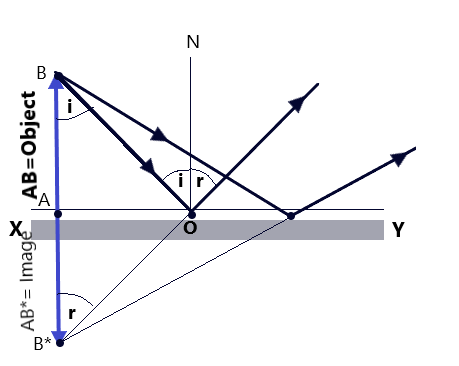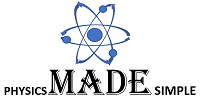Reflection of Light-12
What is Reflection of Light-12
It is the re-bounce of light from a smooth surface after striking it is known as the reflection of light
When a light ray is allowed to incident on a surface, it partly goes back into the same medium as the reflected ray of light, partly absorbed by the surface and the remaining part, if any, is transmitted through the surface. Even a transparent glass surface reflects about 5% of the light falling on this surface.
Highly polished metal surfaces reflect about 80 to 90% of the incident light falling on these surfaces. To reflect the light, still, more efficiently, mirrors are used. A mirror is obtained by depositing a fine layer of silver on the back surface of the glass. Therefore., the reflection of light-12 is defined as the phenomenon in which the light goes back into the same medium after striking a polished and smooth surface.

What are the laws of Reflection? -Reflection of Light-12
Consider a plain mirror XY. When a ray of light AO falls on the mirror at point O, it gets reflected along OB and as shown in figure-01. The light rays AO and OB are known as incident and reflected rays respectively while point O is known as the point of incidence. If we draw ON as normal to the mirror at the point of incidence O, the angle between the incident ray and the normal is called the angle of incidence I, and the angle which the reflected ray makes with the normal is called the angle of reflection r. On the basis of experimental observations, the following two conclusions are made.
- The incident ray, the normal, and the reflected ray all lie in the same plane and at the same point of incidence.
- The angle of incidence i is always equal to the angle of reflection r
These two experimental observations are known as the laws of reflection.
Types of Reflection-Reflection of Light-12
Depending upon the nature of the surfaces in terms of their smoothness and optical planeness, the reflection of light falls into two types- regular reflection and diffused reflection.
Regular Type of Reflection of Light-12

When a parallel beam of light falls on a mirror, (plain or carved), each ray of light is reflected from the mirror, according to the laws of reflection, as shown in the figure, it is called regular reflection. In this type of reflection, all the laws of reflection are obeyed. This type of reflection occurs. When the surface is quite smooth and is optically plane.
Diffuse Reflection:
Diffuse Reflection -Reflection of Light-12

When a parallel beam of light falls on an object, such as a wall floor, paper, and other types of surfaces that are not perfectly smooth, the rays of light are reflected in all possible directions as shown in the figure. This type of reflection is called diffuse reflection. The origin of this type of reflection of light-12 lies in the fact that the surfaces are not perfectly smooth, like a mirror. In the language of physics, these surfaces are not optically plane. One can notice the irregularities in their surfaces with the help of a microscope.
Due to these irregularities in their surfaces, the different rays in a parallel ray of light, come to the incident at different angles of incidence. As a result, the rays of light get reflected practically in all directions. It may be pointed out that for the reflection occurring at each point, the angle of incidence is equal to the angle of reflection. In other words, the laws of reflection are obeyed even in diffusion reflection
Significance of diffuse reflection of Light-12
- The visibility of most of the objects becomes possible due to the diffuse reflection of light from their surfaces.
- An object would appear either dazzlingly dried or quite dark if the diffuse reflection is absent.
- It is only due to a source of light that a soft illumination is produced within the room due to the diffuse reflection of light from the walls of the room.
- The sun’s rays undergo diffuse reflection from the dust particles in the air, surrounding objects, etc. so as to produce general illumination. In absence of a diffuse reflection, the space in the shed would appear almost totally dark.
How the Images are formed by a Plane Mirror Due to Reflection of Light-12

Consider that an object AB is placed in front of a plane mirror XY, as shown in the figure, the rays of light BO and BO* fall on the mirror at different angles of the incidence and obeying the laws of reflection, they get reflected in the directions such that, the angel of refraction is same as the angel to f incidence of the rays, in the form of a divergent beam of light The ray of light, incident, normally along BA, will be reflected back along AB.
To the eyes of the observer, all the reflected rays appear to come from point B* and accordingly, AB* is called the virtual image of the object AB, it can be easily proved that the object and the image lie at the equal perpendicular distances from the plane mirror, therefore, AB = AB*.
Characteristics of the image formed by a plane mirror.
- The image is as far behind the mirror as the object in front of it.
- The size of the image is the same as that of the object.
- The image formed is virtual since the image is formed behind the mirror. It cannot be produced on the screen. The image formed is erect in nature.
- The image formed is laterally inverted. The lateral inversion means that the right side of the object appears as the left side of the image and vice versa.
See more for Numerical Problems
